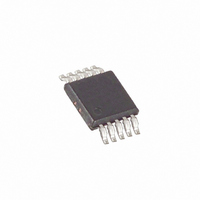MAX1846EUB+ Maxim Integrated Products, MAX1846EUB+ Datasheet - Page 13

MAX1846EUB+
Manufacturer Part Number
MAX1846EUB+
Description
IC CNTRLR PWM HI EFF 10-UMAX
Manufacturer
Maxim Integrated Products
Type
Inverting, Flybackr
Datasheet
1.MAX1847EEE.pdf
(20 pages)
Specifications of MAX1846EUB+
Internal Switch(s)
No
Synchronous Rectifier
No
Number Of Outputs
1
Voltage - Output
-0.5 ~ -200 V
Current - Output
5A
Frequency - Switching
100kHz ~ 500kHz
Voltage - Input
3 ~ 16.5 V
Operating Temperature
-40°C ~ 85°C
Mounting Type
Surface Mount
Package / Case
10-MSOP, Micro10™, 10-uMAX, 10-uSOP
Power - Output
444mW
Duty Cycle (max)
97 %
Output Voltage
1.25 V
Mounting Style
SMD/SMT
Switching Frequency
500 KHz
Operating Supply Voltage
3 V to 16.5 V
Supply Current
0.75 mA
Maximum Operating Temperature
+ 85 C
Fall Time
200 ns
Minimum Operating Temperature
- 40 C
Output Power
444 mW
Rise Time
200 ns
Lead Free Status / RoHS Status
Lead free / RoHS Compliant
2)
3)
4)
5)
Remember that V
When running at the maximum oscillator frequency
(f
exceed the minimum value of D
Electrical Characteristics table. For designs that
exceed the D
can reduce the duty cycle and allow higher operating
frequencies.
The oscillator frequency is set by a resistor, RFREQ,
which is connected from FREQ to GND. The relation-
ship between fOSC (in Hz) and RFREQ (in Ω) is slightly
nonlinear, as illustrated in the Typical Operating
Characteristics. Choose the resistor value from the
graph and check the oscillator frequency using the fol-
lowing formula:
The SYNC input provides external-clock synchroniza-
tion (if desired). When SYNC is driven with an external
clock, the frequency of the clock directly sets the
MAX1847’s switching frequency. A rising clock edge
on SYNC is interpreted as a synchronization input. If
the sync signal is lost, the internal oscillator takes over
at the end of the last cycle, and the frequency is
f
OSC
OSCILLATOR
=
f
Higher frequencies allow the use of smaller value
(hence smaller size) inductors and capacitors.
Higher frequencies consume more operating
power both to operate the IC and to charge and
discharge the gate at the external FET, which
tends to reduce the efficiency at light loads.
Higher frequencies may exhibit lower overall effi-
ciency due to more transition losses in the FET;
however, this shortcoming can often be nullified
by trading some of the inductor and capacitor size
benefits for lower-resistance components.
High-duty-cycle applications may require lower
frequencies to accommodate the controller mini-
mum off-time of 0.4µs. Calculate the maximum
oscillator frequency with the following formula:
OSC MAX
⎡
⎣ ⎢
(
5 21 10
.
(
×
External Synchronization (MAX1847 only)
−
) and maximum duty cycle (D
7
)
MAX
)
=
×
+
OUT
(
V
t
1 92
OFF MIN
IN MIN
______________________________________________________________________________________
.
and f
(
×
is negative when using this formula.
1
(
10
V
−
)
IN MIN
OSC(MAX)
11
−
)
)
(
V
×
SW
R
1
FREQ
)
−
−
V
V
−
, an autotransformer
SW
LIM
(
4 86
MAX
.
−
−
×
V
10
V
LIM
stated in the
OUT
−
High-Efficiency, Current-Mode,
19
MAX
)
×
+
), do not
(
R
V
FREQ
D
)
2
⎤
⎦ ⎥
Inverting PWM Controller
returned to the rate set by R
that f
The inductance value determines the operation of the
current-mode regulator. Except for low-current applica-
tions, most circuits are more efficient and economical
operating in continuous mode, which refers to continu-
ous current in the inductor. In continuous mode there is
a trade-off between efficiency and transient response.
Higher inductance means lower inductor ripple current,
lower peak current, lower switching losses, and, there-
fore, higher efficiency. Lower inductance means higher
inductor ripple current and faster transient response. A
reasonable compromise is to choose the ratio of induc-
tor ripple current to average continuous current at mini-
mum duty cycle to be 0.4. Calculate the inductor ripple
with the following formula:
Then calculate an inductance value:
Choose the closest standard value. Once again, remem-
ber that V
The peak inductor current required for a particular out-
put is:
where I
is the inductor peak-to-peak ripple current. The I
and I
where L is the selected inductance value. The satura-
tion rating of the selected inductor should meet or
exceed the calculated value for I
coil types can be operated up to 20% over their satura-
tion rating without difficulty. In addition to the saturation
criteria, the inductor should have as low a series resis-
I
0 4 .
RIPPLE
OSC
LPP
×
I
I
LDC
LPP
LDC
I
=
LOAD MAX
L = (V
terms are determined as follows:
OUT
= 0.9 x f
Determining Peak Inductor Current
=
=
is the average DC inductor current and I
(
(
(
is negative when using this formula.
V
1
IN(MAX)
IN MIN
I
LPEAK
I
−
LOAD
(
(
)
V
SYNC
D
IN MAX
×
MAX
Choosing Inductance Value
(
(
)
V
IN MAX
/ I
= I
−
.
(
)
RIPPLE
)
LDC
V
−
L x f
SW
V
)
SW
FREQ
−
+ (I
) x (D
V
−
OSC
SW
−
LPP
. Choose R
V
LPEAK
V
LIM
LIM
−
MIN
V
/ 2)
)
LIM
)
, although most
/ f
x D
−
OSC
V
OUT
FREQ
MAX
)
+
such
V
LDC
D
LPP
13
)











